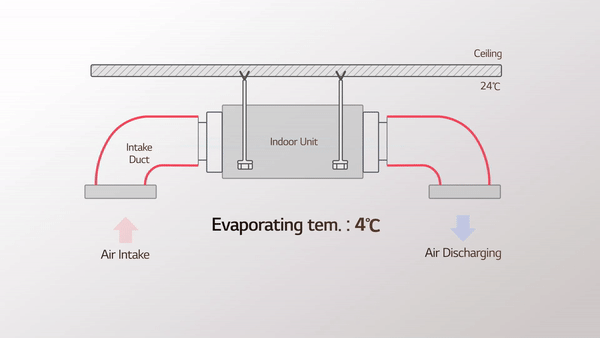Thermal comfort
Sustainable
cooling solutions :
New technology for sophisticated renovation at WeWork

The renovation of the EU’s building stock is one of the top priorities of the European Green Deal, but comes with many challenges since the heating and cooling equipment needs to be adapted to the built environment. Aviation House was originally built between 1909 and 1911 in the borough of Camden in London as the Church of the Holy Trinity and was redeveloped as offices in 1999. As the building is tucked between commercial and residential areas, with only limited rooftop space, some outdoor units needed to be installed on the ground floor while having to comply with strict noise regulations. The exposed ceiling structure of the building added to the challenge of the installation inside the building.
Customised Multi V 5 VRF system to match customer specifications and UK regulatory requirements in the context of a building renovation
- Adapting to strict noise regulations:
According to requirements of the National Planning Policy in England, a soundproof barrier needed to be installed around the ground floor units. This barrier negatively impacted air suction capabilities of the units on the ground and ultimately caused them to lose overall capacity. CFD analysis was provided by LG to secure targeted capacity with smooth air intake without short cycling of the system.
- Allowing for high evaporating temperature:
In order to prevent condensation from forming on the ducts throughout the facility due to the exposed ceiling structure, a target discharge temperature of 12ºC or above was required. This would also require a higher evaporating temperature from the system. Indoor units are produced with a factory set evaporating temperature of 4ºC, which results in a discharge air temperature of 10ºC-11ºC. To overcome this issue, LG developed customized fan coil performance data to produce an evaporating temperature of 9ºC and a supply air temperature of 12ºC~14ºC.
- Building Management System (BMS) Integration.
A precise and comprehensive control solution is imperative for an HVAC system in an office environment. To provide an optimal interface with the on-site BMS, LG installed their AC Smart 5 solution with BACnet gateway. AC Smart 5 provided seamless integration with the Aviation House BMS without any additional devices.
Click here and here for more information
Exposed ceilings and duct without insulation presented a major challenge in discharge air temperature management
Customized fan coil performance data was utilized to manage condensation forming on ducts

Aviation House before and after renovations

- Turnaround speed for design customisation enabled the project to be completed within 16 weeks.
- Computational fluid dynamics analysis by LG software made system design to comply with UK’s national planning policy and fulfil the necessary capacity for the system to operate.
- Higher discharging air temperature was made possible to avoid condensation forming on the surface of the non-concealed indoor units.
- To enable reliable and comprehensive control of the HVAC system with the existing building management system, LG installed an interface connecting all LG units with the central system for an optimal control.
- LG provided training to the on-site building managers to make the most of the building’s operation and thus ensure maximum comfort to its visitors.
Click here to download the case study
